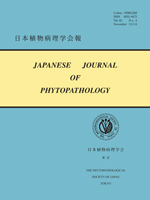
- Issue 4 Pages 213-
- Issue 3 Pages 113-
- Issue 2 Pages 65-
- Issue 1 Pages 1-
- |<
- <
- 1
- >
- >|
-
2021Volume 87Issue 4 Pages 213-
Published: November 25, 2021
Released on J-STAGE: December 23, 2021
JOURNAL FREE ACCESSDownload PDF (222K)
-
I. OKABE2021Volume 87Issue 4 Pages 214-221
Published: November 25, 2021
Released on J-STAGE: December 23, 2021
JOURNAL FREE ACCESSAirborne conidia of Setosphaeria turcica, the pathogen causing northern leaf blight (NLB), were trapped in a Durham’s sampler after nights that had relative humidity ≥90% for 10 or more hours and temperature ≥15°C. When conidial dispersal was followed by another warm, humid night favorable for infection, the number of NLB lesions increased rapidly after a latent period of a few weeks.
View full abstractDownload PDF (1784K) -
K. ISHIKAWA, T. HORI, T. KURODA2021Volume 87Issue 4 Pages 222-230
Published: November 25, 2021
Released on J-STAGE: December 23, 2021
JOURNAL FREE ACCESSTo elucidate changes in the frequency of pathogenic races of Pyricularia oryzae over time when rice multilines are grown, we grew a 1:2:5:2 mixture of cultivar Koshihikari and its isogenic lines (ILs), each carrying a blast-resistance gene (Pia, Pii, Pita-2 or Piz), to serial inoculations and tested the reliability of a simulation model. For the initial inoculum in a greenhouse, 600 seedlings of Koshihikari and its ILs seedlings inoculated with blast isolates race 001.0, 003.0, 007.0, 037.1 and 041.0 were grown next to the mixed ILs, then the ILs produced a new generation of inoculum. As the number of infection cycles increased, the predominant race changed, until cycle 16 when race 007.0 established itself as the dominant isolate. In a similar test using nine ILs (Pik-s, Pia, Pii, Pita-2, Piz, Pik, Pik-m, Piz-t and Pib), rice cultivar Koshihikari and its ILs were mixed at an equal ratio, and race 037.1 became dominant. In field trials using an IL multiline (Pik-s, Pia and Pii) and races 001.0, 003.0 and 007.0 as inoculum, race 007.0 became dominant. Race frequencies predicted by our simulation model were similar to the results of the greenhouse and field trials. This simulation model can now be used to reliably predict the race composition of leaf blast during multiline rice cultivation.
View full abstractDownload PDF (657K) -
A. SAKAMOTO, S. UZUHASHI, H. KITO, H. HOSHI, M. KUBOTA, A. TAKAHARA, Y ...2021Volume 87Issue 4 Pages 231-238
Published: November 25, 2021
Released on J-STAGE: December 23, 2021
JOURNAL FREE ACCESSPhytophthora rot of Angelica keiskei during the warm season is caused by Phytophthora nicotianae; however, few reports are available on which pathogen(s) cause the disease during the cool season. Therefore, 12 Phytophthora isolates that were obtained from diseased plants of Angelica keiskei in the Izu Islands, Japan from February to June of 2017 and 2018 were examined, analyzed taxonomically, and tested for pathogenicity. All isolates reproduced the original symptoms after inoculation of Angelica keiskei. In our phylogenetic tree based on cox1 sequences, these isolates formed a monophyletic clade with Phytophthora taxon parsley and Phytophthora sp. hybrid type 1. Five representative isolates were morphologically identical with Phytophthora sp. hybrid type 1 and caused the symptoms on onion. Based on these results, the isolates were identified as Phytophthora sp. hybrid type 1. This is the first report of Phytophthora rot of Angelica keiskei caused Phytophthora sp. hybrid type 1.
View full abstractDownload PDF (6262K) -
K. NISHIOKA, Y. NISHI, N. OMATSU, O. SUEKAWA, S. KODAMA, S. UENOSONO2021Volume 87Issue 4 Pages 239-250
Published: November 25, 2021
Released on J-STAGE: December 23, 2021
JOURNAL FREE ACCESSDiaporthe destruens is transmitted to seedlings via seed potatoes. Since the first report of foot rot disease in Kagoshima Prefecture in 2018, the disease now affects seed plots in the major production areas in the prefecture, affecting more fields each year. Examining seed potatoes in storage, here we clarified that the disease can progress in stored seed potatoes that are harvested from fields with foot rot disease and stored as seed stock, and just one diseased tuber in the storage container will serve as a source of inoculum to infect adjacent potatoes. For efficient storage with low risk of foot rot disease of harvested seed potatoes, we determined four points of control to reduce rot in storage. (1) Seed potatoes should be collected from plants with no symptoms of foot rot disease on the crown and the stalks. (2) Cleaning, sorting, and cutting of seed potatoes, then disinfecting with fungicide before storage extensively suppresses the disease. (3) Treatment with warm water at 48°C for 10 min kills spores of Diaporthe destruens. (4) Steam treatment at 48°C for 40 min (based on point 3) of seed potatoes harvested from a field affected by foot rot disease extensively suppresses foot rot in storage without affecting germination potential of seed potatoes.
View full abstractDownload PDF (1345K)
- |<
- <
- 1
- >
- >|